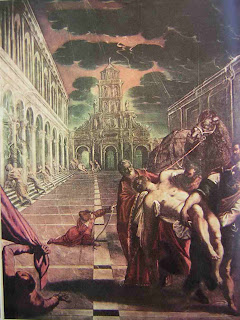 |
| Tintoretto. Note the general feeling of disorder,sense of chaos. |
Influences of environment & attitudes on artistic
imagery.
The connection between artistic output, and the political,
and social conditions in any particular period of time, are often overlooked by
the general viewer when confronting works of art. This lack of understanding
robs many of the full enjoyment of their experience. Historically, there has
always been this relationship between the visual arts and meaning. Very much
like a mirror held up to the world at a fixed point in time. It is the cement
that gives the work its’ intellectual meaning.
This is nothing new, looking at a roomful of Roman busts one
is left in no doubt about the patriarchal nature of Roman society. The mannerist sculptures of Michelangelo and
his fellow mannerist, such as Parmigianino or Tintoretto take on a new meaning
when viewed from the perspective of the Counter Reformation, and the
persecution of each other by Catholic and Protestant alike. The moral
corruption of the papacy, the French invasions of Rome, the sack of that city
in 1527 were just a few of the external forces creating a world in crises in
the artists’ mind. Likewise the Rococo paintings of Watteau, an 18th
cent world of over indulgence that prepares us for the blood bath of the French
Revolution. Why do people love the Impressionists so much, may I dare to
suggest that most likely these paintings offer us a window onto a middle class
world created by the industrial revolution, with the increased living standards
of a leisured class..
Parmigianino,
Note the lack of security surrounding baby Jesus.
Tintoretto,
The sense that this is the end of the world, day of judgement.
“Serious” painting to a great extent [ excluding the
decorative] has generally served this purpose, and anyone viewing the extreme volatile
nature of 20th cent visual art would not be surprised to acknowledge
that the continual social and political crises of our times are suggested by
the century’s visual art. In addition we have the extreme pursuit of materialism
and decline in religious belief in the west at least reinforcing this century’s
visual art.
The main purpose of this discourse was to encourage the viewing
the work of the British painter Frances Bacon in this light. The 1940’s, 50’s
and 60’s in Britain were hardly Utopian. The trauma of the 2nd World
War, rationing on into the late 60’s, followed by a watershed in moral and
sexual attitude in the 60’s. Bacon a homosexual must have experienced hostility socially
in general. There was still little tolerance in such matters then or even now,
the isolation he must have felt makes its presence felt in his paintings during
this period. His inner feelings of lostness, and the enclosure of the figure
within a suggested room reinforces this feeling. These figures although enclosure
are still accessible to society at large.
This break down in social values in general did not
disappear with Bacon’s death, but is only too apparent today. However much
artist attempt to hold up the mirror to reality, the general public does not
wish to look, learn, and hopefully correct its’ course. The current output of conceptual
work, and sense of poverty of idea does not give confidence, but I may be wrong!
Francis Bacon.
Man in an open room, his figures are isolated in an unfriendly world
.




No comments:
Post a Comment